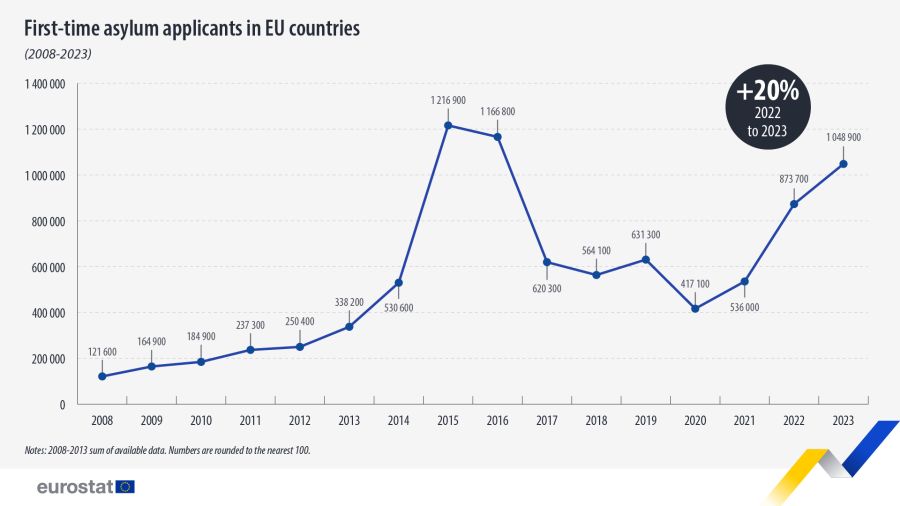Asylum applications - annual statistics
Data extracted on 20 March 2024.
Planned article update: March 2025.
Highlights
This article outlines recent developments in relation to the number of asylum applicants in the European Union (EU). Asylum is a form of international protection given by a state on its territory. It is granted to a person who is unable to seek protection in their country of citizenship and/or residence, in particular for fear of being persecuted for reasons of race, religion, nationality, membership of a particular social group, or political opinion.
The legal basis for the asylum data collection is Regulation (EC) No 862/2007. An amendment to this regulation adopted in June 2020 introduced additional new statistics. It increased the frequency, timeliness and the level of detail of asylum statistics from reference year 2021, including more detailed information on unaccompanied minors who represent a particularly vulnerable group seeking protection. In addition, Eurostat started to collect data on subsequent asylum applicants, on asylum applications under accelerated procedure, on asylum applicants benefiting from material reception conditions and on types of withdrawals of asylum applications. The new statistics are also included in this article.
Full article
Over 1 million first-time asylum applicants in 2023
In 2023, there were 1 048 880 first-time asylum applicants (non-EU citizens) for international protection in countries of the EU (Figure 1). This is an increase of 20.1 % compared with 2022 (873 680) and it is the highest number since the peaks recorded during the refugee crisis related to the war in Syria in 2015 and 2016.
The number of first-time asylum applicants in the EU accounted for a large majority (92.9 %) of the total number of asylum applicants (1 129 640) recorded in 2023.
Additionally in 2023, there were 75 290 subsequent asylum applicants recorded across the EU countries. This was down 6.7 % when compared with 2022 (80 705).
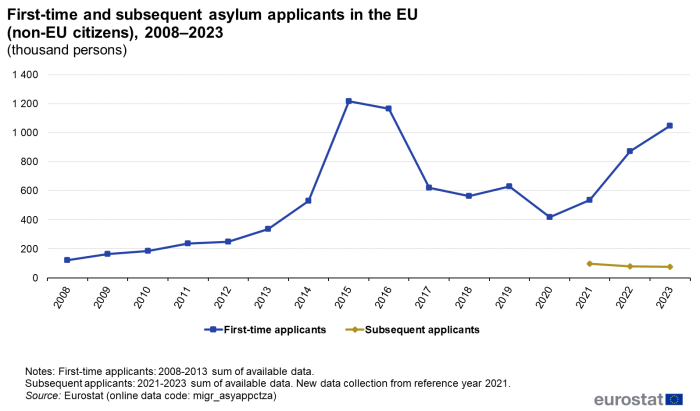
(thousand persons)
Source: Eurostat (migr_asyappctza)
In 2023, more males than females sought asylum in the EU countries (Figure 2). Men aged 18-34 years accounted for 41.7 % of the total number of first-time applicants. The proportions of boys and girls aged less than 14 years were similar, while there were more boys (5.1 %) than girls (1.5 %) aged 14-17 years.
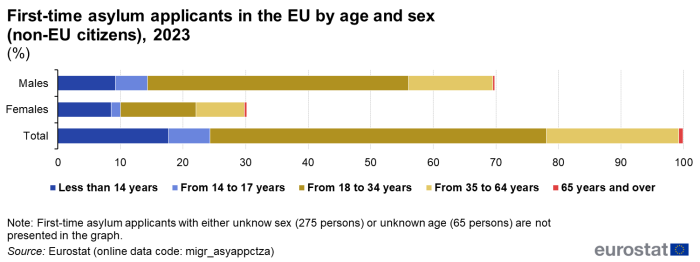
(%)
Source: Eurostat (migr_asyappctza)
Main countries of destination – Germany, Spain, France and Italy
Germany accounted for 31.4 % of all first-time asylum applicants in the EU, with 329 035 applicants registered in 2023, (Figure 3). It was followed by Spain (160 460, or 15.3 %), France (145 095, or 13.8 %) and Italy (130 565, or 12.4 %). The lowest numbers of first-time asylum applicants were observed in 2023 in Hungary (30), Slovakia (370), Malta (490) and Lithuania (510).
Among EU countries, the number of first-time asylum applicants increased in 13 countries in 2023. The largest relative increases, compared with the previous year, were in Latvia (+198.2 %, or 1 080 more first-time asylum seekers in 2023 than in 2022), Greece (+98.8 %, or 28 770 more), Italy (+69.1 %, or 53 365 more) and Germany (+51.1 %, or 111 300 more). The largest decreases were observed in Austria (-49.3 %, or 54 170 less first-time asylum seekers in 2023 than in 2022), Denmark (-47.4 %, or 2 120 less), Malta (-46.4 %, or 425 less), Cyprus (-46.0 %, or 9 930 less) and Lithuania (-43.6 %, or 395 less).
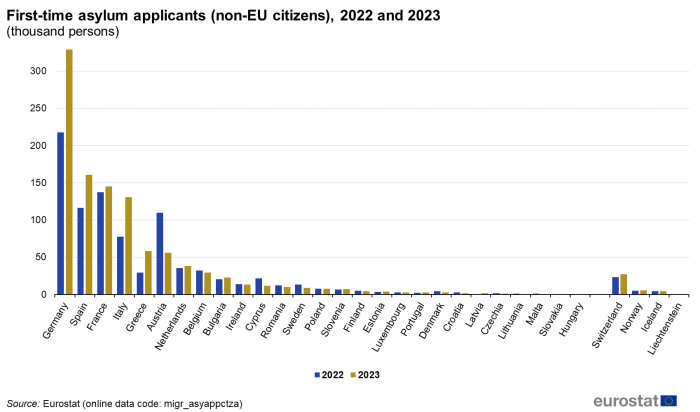
(thousand persons)
Source: Eurostat (migr_asyappctza)
Compared with the population of each EU country, the highest number of first-time asylum applicants in 2023 was registered in Cyprus (13 first-time asylum applicants per thousand people), ahead of Austria and Greece (6 each) (Map 1). Less than one first-time asylum applicant per thousand people was registered in Croatia, Denmark, Portugal, Poland, Lithuania, Czechia, Slovakia and Hungary.
In 2023, there were 2 first-time asylum applicants per thousand people in the EU.
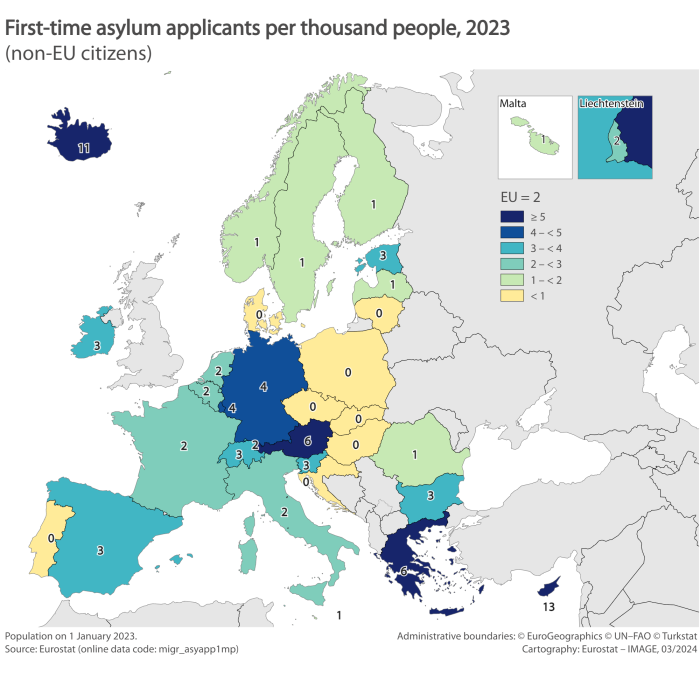
(non-EU citizens)
Source: Eurostat (migr_asyapp1mp)
Citizenship of first-time applicants – mainly Syrian, Afghan and Turk
Syrians, Afghans, Turks, Venezuelans and Colombians lodged the most applications for asylum – together accounting for almost half (48.0 %) of all first-time asylum applicants in EU countries in 2023 (Figure 4).
Since 2013, Syria continues to be the main country of citizenship of asylum seekers in the EU. In 2023, the number of Syrian first-time asylum applicants in the EU increased to 183 035 (from 131 790 in 2022), and their share in the total EU first-time asylum applicants rose from 15.1 % to 17.5 %.
Afghanistan was the second main country of citizenship for the six consecutive year (100 935 in 2023, or 9.6 % of the EU total). Applicants from Türkiye represented 8.6 % of the EU total with 89 970 applicants in 2023. Venezuela and Colombia were the fourth and fifth main countries of citizenship in 2023, totalling 67 085 (6.4 % of the EU total) and 62 015 (5.9 %) applicants, respectively.
Among the 30 most common citizenships of first-time asylum applicants in the EU in 2023, the number of asylum seekers increased for 21 of them. The largest increases in absolute terms compared with 2022 were observed for Syrians (51 245 more applications), followed by Turks (41 370 more), Colombians (19 595 more) and Venezuelans (17 035 more). In contrast, the number of asylum seekers decreased the most among citizens of India (17 400 less), Afghanistan (12 915 less) and Ukraine (12 070 less).
The most substantial increases in relative terms were recorded for citizens of Burkina Faso (+569.2 %) and Côte d'Ivoire (+124.1 %). The most substantial relative decrease was recorded for citizens of India (-67.3 %).

(thousand persons)
Source: Eurostat (migr_asyappctza)
In 2023, Syrian was the main citizenship of asylum seekers in 12 EU countries (Table 1). The citizens of Bangladesh, Belarus, Russia and Türkiye were the main groups of asylum seekers in two countries. In seven countries, the main country of citizenship of asylum seekers was Afghanistan, Gambia, Morocco, Nigeria, Somalia, Ukraine or Venezuela. For Syrians, Turks and Afghans, the largest numbers were registered in Germany (56.2 % of all Syrian asylum seekers in the EU, 68.0 % of Turks and 50.8 % of Afghans). For Venezuelans and Colombians, the vast majority were registered in Spain (respectively 89.4 % and 85.5 %).
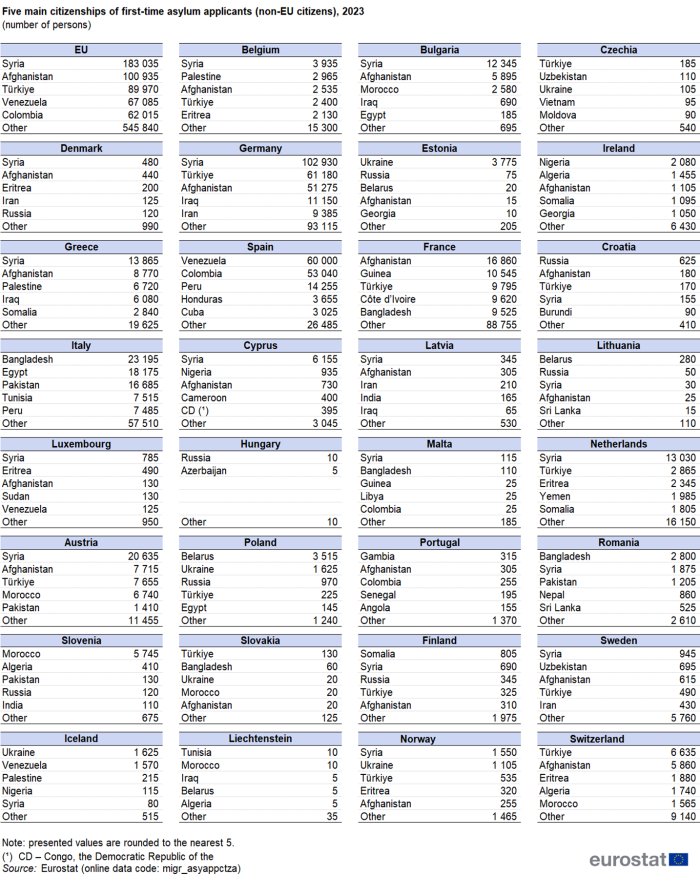
(number of persons)
Source: Eurostat (migr_asyappctza)
Applications by unaccompanied minors
An unaccompanied minor is a person under the age of 18 years who arrives on the territory of an EU Member State without an accompanying responsible adult, or who is left unaccompanied after arrival.
In 2023, based on available data, the total number of unaccompanied minors applying for asylum in EU countries for the first time reached 41 525 persons, an increase of 4.0 % compared to 2022 (39 915) (Figure 5).
The largest number of unaccompanied minors were reported by Germany (15 270), followed at a distance, by the Netherlands (6 045) and Austria (5 055). More than 2 000 unaccompanied minors applied for asylum for the first time in Bulgaria (3 845), Greece (2 635), Belgium (2 550), Spain (2 505) and Italy (2 205). Among these eight EU countries, the number of unaccompanied minors rose in five compared with 2022, with the highest absolute increase observed in Germany (7 995 applicants more). The highest decrease was recorded for Austria (8 160 applicants less).
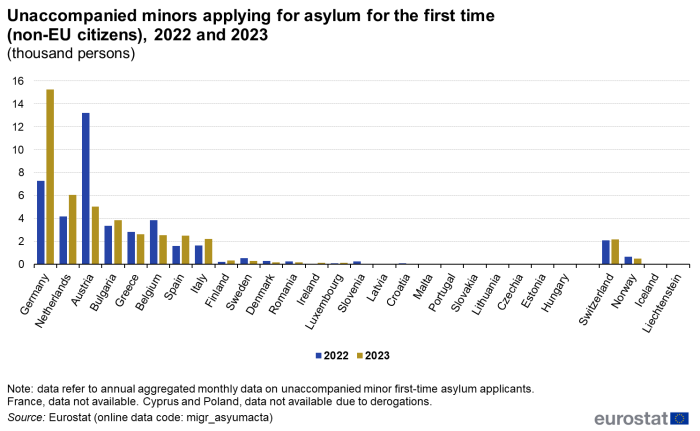
(thousand persons)
Source: Eurostat (migr_asyumacta)
In 2023, most of the asylum applications from unaccompanied minors were lodged either by Syrians (13 500 people or 32.5 % of the total number of unaccompanied minors applying for asylum in EU countries for the first time) or Afghans (12 090 or 29.1 %) (Figure 6).

(%)
Source: Eurostat (migr_asyumacta)
Applications under the accelerated procedure
In 2021, Eurostat started collecting new data on asylum applications under an accelerated procedure. Article 31(8) of Directive 2013/32/EU identifies ten grounds where the accelerated procedure may be applied, and thus where an EU Member State may reject a claim as manifestly unfounded. This concerns, for instance, cases where the applicant has only raised issues not relevant to refugee or subsidiary protection status, or if the applicant comes from a "safe country of origin" or where the applicant refuses to be fingerprinted.
In 2023, based on available data, the total number of applications under the accelerated procedure in EU countries was applied to 92 000 persons, a decrease of 19.7 % compared to 2022 (114 620) (Figure 7).
The largest number of asylum applications under an accelerated procedure in 2023 was recorded in France (47 440), followed at a distance, by Italy (14 630), Greece (9 920) and Austria (8 190). No applications under the accelerated procedure were applied in Hungary and Slovakia.
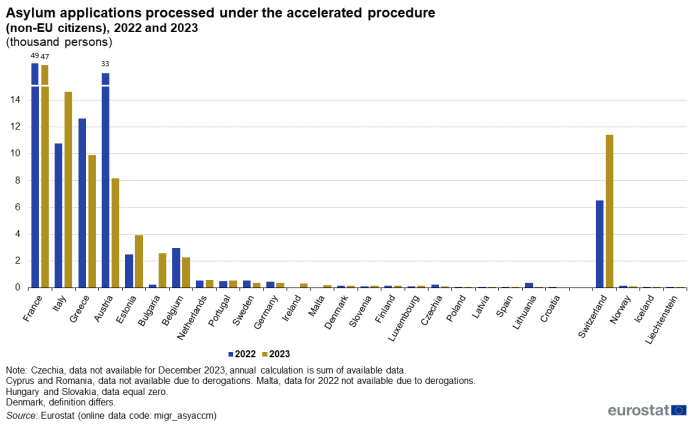
(thousand persons)
Source: Eurostat (migr_asydcfsta) and (migr_asyaccm)
Applicants receiving material reception conditions at the end of the year
Also, from the reference year 2021, the new data on the number of applicants receiving material reception conditions at the end of the reference year have been collected by Eurostat. The Directive 2013/33/EU aims to harmonise reception/living conditions for applicants for international protection throughout the EU. The material reception conditions include housing, food and clothing provided in kind, or as financial allowances or in vouchers, or a combination of the three, and a daily expenses allowance. Additionally, EU countries should ensure that asylum applicants receive necessary health care and have access to the labour market within 9 months from the date of their application for international protection, and children under 18 who are applicants or children of applicants can access education.
According to the latest available data, at the end of 2022, the largest number of applicants receiving material reception conditions was registered in France (182 485) and Italy (110 295) (Figure 8).
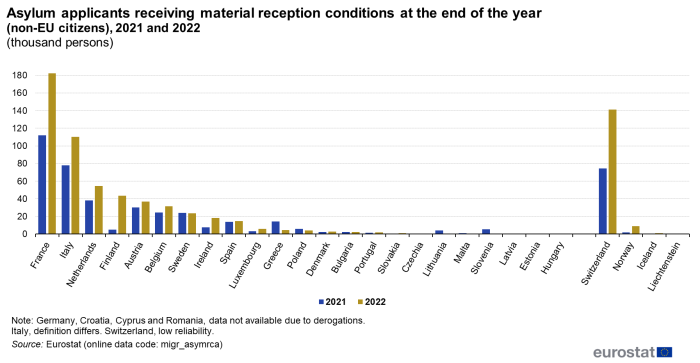
(thousand persons)
Source: Eurostat (migr_asymrca)
Pending applications at the end of the year
Pending applications for international protection are applications that have been made at any time and are still under consideration by the national authorities at the end of the reference period. In other words, they refer to the number of asylum seekers waiting for a decision at the end of the year. These statistics are also intended to measure how national authorities are coping with the workload associated with processing new applications.
At the end of December 2023, 1 144 085 applications for international protection in EU Member States were still under consideration by national authorities, an increase of 29.5 % compared to December 2022 (883 450) (Figure 9). Almost one-third of the total number of pending applications in December 2023 was recorded in Germany (368 360, or 32.3 % of the EU total), ahead of Spain (204 275, or 17.9 %), Italy (146 940, or 12.8 %) and France (146 175, or 12.8 %). These four EU countries together accounted for over three-quarters of all pending applications in the EU at the end of 2023. In contrast, Slovakia and Hungary reported less than 100 pending applications at the end of 2023, 95 and 15 respectively.
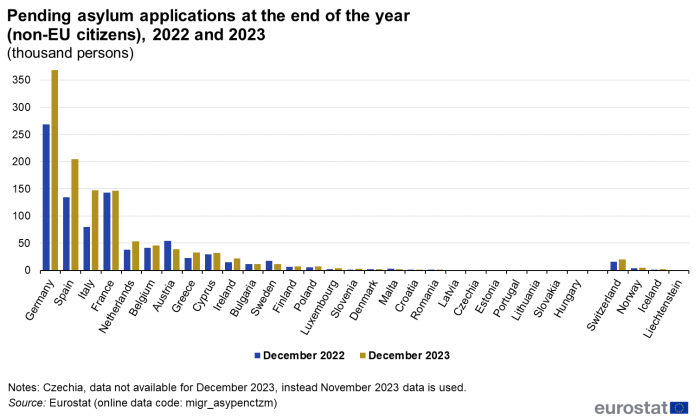
(thousand persons)
Source: Eurostat (migr_asypenctzm)
Asylum applications withdrawn
Asylum application withdrawal is an action by which the applicant terminates the procedures initiated by the submission of their application for international protection. Eurostat collects data on explicit and implicit types of withdrawal. “Explicit” withdrawals refer to cases where the applicant no longer needs international protection and notifies the authorities to withdraw the application. “Implicit” withdrawals concern cases where the authorities fail to locate the applicant and therefore it is considered that the applicant has abandoned the procedure.
In 2023, 125 370 asylum applications were withdrawn across the EU countries (Figure 10). The largest number of withdrawals was registered in Austria (30 805), followed, at a distance, by Bulgaria (16 395), Germany (12 150), Greece (11 555), Cyprus (10 355) and Italy (9 855).
In most EU countries most withdrawals were implicit, with the highest shares observed in Austria (100 %), Spain (99.6 %), Slovenia (99.1 %), Bulgaria (98.9 %) and Italy (98.4 %). In contrast, most explicit withdrawals were in Estonia (96.6 %), Ireland (93.7 %) and France (89.9 %).

(thousand persons)
Source: Eurostat (migr_asywitha)
Source data for tables and graphs
Data sources
Eurostat produces statistics on a range of issues relating to international migration. Between 1986 and 2007, data on asylum was collected on the basis of a gentlemen’s agreement. Since 2008 data have been provided to Eurostat under the provisions of Article 4 of Regulation (EC) No 862/2007.
Data for statistics on asylum applications, including applications by unaccompanied minors are provided to Eurostat with a monthly frequency. The statistics are based on administrative sources and are provided to Eurostat by statistical authorities, ministries of the interior or related immigration agencies in the EU Member States.
Asylum applicants mean asylum seekers who have lodged a claim (asylum application) and whose claim is under consideration by the relevant authority.
Annual aggregated data on asylum applicants are computed from monthly data. Annual aggregated data on first-time unaccompanied minor asylum applicants are computed from monthly data and refer to minors according to the age claimed by applicant at the time of application. This number is different from the statistics on asylum applicants considered to be unaccompanied minors after the age assessment procedure has been completed.
Limitations on data availability affecting the information presented in this article:
- Data for unaccompanied minors for France are not available. For Cyprus and Poland, data not available due to derogations.
- Data for asylum applications under the accelerated procedure for Cyprus and Romania, data not available due to derogations. For Malta, data for 2022 not available due to derogation. For Czechia, data not available for December 2023.
- Data for asylum applicants having benefited from material reception conditions at the end of the reference year, for Germany, Croatia, Cyprus and Romania, data not available due to derogations.
- Data for pending asylum applications for Czechia not available for December 2023. Instead, November 2023 data is used.
- Data for asylum applications withdrawn by type of withdrawal, for Romania data by type of withdrawal not available due to derogation.
Presented values are rounded to the nearest 5.
Context
The 1951 Geneva Convention relating to the status of refugees (as amended by the 1967 New York Protocol) has, for around 70 years, defined who is a refugee, and laid down a common approach towards refugees that has been one of the cornerstones for the development of a common asylum system within the EU. Since 1999, the EU has worked towards creating a common European asylum regime in accordance with the Geneva Convention and other applicable international instruments.
The Hague programme was adopted by heads of state and government on 5 November 2004. It puts forward the idea of a common European asylum system (CEAS), in particular, it raises the challenge to establish common procedures and uniform status for those granted asylum or subsidiary protection. The European Commission’s policy plan on asylum (COM(2008) 360 final) was presented in June 2008 which included three pillars to underpin the development of the CEAS:
- bringing more harmonisation to standards of protection by further aligning the EU Member States’ asylum legislation;
- effective and well-supported practical cooperation;
- increased solidarity and sense of responsibility among EU Member States, and between the EU and non-member countries.
In May 2010, the European Commission presented an action plan for unaccompanied minors (COM(2010) 213 final), who are regarded as the most exposed and vulnerable victims of migration. This plan aims to set-up a coordinated approach and commits all EU Member States to grant high standards of reception, protection and integration for unaccompanied minors. As a complement to this action plan, the European Migration Network has produced a comprehensive EU study on reception policies, as well as return and integration arrangements for unaccompanied minors.
A number of directives in this area have been developed. The four main legal instruments on asylum are:
- the Qualification Directive 2011/95/EU on standards for the qualification of non-EU nationals and stateless persons as beneficiaries of international protection, for a uniform status for refugees or for persons eligible for subsidiary protection;
- the Procedures Directive 2013/32/EU on common procedures for granting and withdrawing international protection;
- the Conditions Directive 2013/33/EU laying down standards for the reception of applicants for international protection;
- the Dublin Regulation (EU) 604/2013 establishing the criteria and mechanisms for determining the EU Member State responsible for examining an application for international protection lodged in one of the Member States by a third-country national (national of a non-member country) or stateless person.
EU operational and financial support has been instrumental in helping Member States to address the migration challenge. In particular, the European Commission offers Member States continued financial support under the Asylum, Migration and Integration Fund (AMIF). AMIF has effectively and successfully supported the Union's joint response to the migration crisis, while also providing a sign of solidarity to the Member States on the frontline.
In April 2016, the European Commission adopted a Communication (COM(2016) 197 final) launching the process for a reform of the CEAS. This included options for a fair and sustainable system for allocating asylum applicants among EU Member States, a further harmonisation of asylum procedures and standards to create a level playing field across the EU and thereby reduce pull factors inducing irregular secondary movements, and a strengthening of the mandate of the European Union Agency for Asylum (EUAA).
In May 2016, the European Commission presented a first package of reforms, including proposals for establishing a sustainable and fair Dublin system (COM(2016) 270 final), reinforcing the Eurodac system (COM(2016) 272 final) and establishing a European Agency for Asylum (COM(2016) 271 final).
In July 2016, the European Commission put forward a second set of proposals related to the reform of the CEAS, for example to establish a resettlement framework for the EU (COM(2016) 468 final) and a common procedure for international protection (COM(2016) 467 final) as well as a recast of the legislation on the standards for the reception of applicants for international protection (COM(2016) 465 final).
In March 2019, the European Commission reported on the progress made over the past 4 years and set out the measures still required to address immediate and future migration challenges (COM/2019/126 final).
In September 2020, the European Commission presented the New Pact on Migration and Asylum. This pact provides a comprehensive approach, bringing together policy in the areas of migration, asylum, integration and border management, recognising that the overall effectiveness depends on progress on all fronts. It creates faster, seamless migration processes and stronger governance of migration and borders policies, supported by modern IT systems and more effective agencies. It aims to reduce unsafe and irregular routes and promote sustainable and safe legal pathways for those in need of protection. It reflects the reality that most migrants come to the EU through legal channels, which should be better matched to EU labour market needs. In December 2023, the Pact was agreed between the European Parliament and the Council.
Russia’s invasion of Ukraine
On 4 March 2022, the Council unanimously adopted an implementing decision introducing temporary protection due to the mass inflow of persons fleeing Ukraine as a consequence of Russia's invasion.
The activated Temporary Protection Directive provides special procedures to deal with mass inflows of displaced persons for the first time. Temporary protection is an exceptional measure to provide immediate and temporary protection to displaced persons from non-EU countries and those unable to return to their country of origin.
It applies when there is a risk that the standard asylum system is struggling to cope with demand stemming from a mass inflow, risking a negative impact on the processing of claims.
Requirements for reporting such statistics already exist in Article 4(1)(c) and 4(3)(e) of Regulation (EC) No 862/2007. They have been implemented for the first time with the transmission of data on international protection as follows:
- data for the first quarter of 2022 due by 31 May 2022;
- annual data for 2022 – due by 31 March 2023.
Quarterly and annual data on temporary protection are available in the Eurostat database in the following datasets: quarterly data and annual data.
In addition, in order to respond to emerging data needs, in March 2022 Eurostat proposed a voluntary collection of more frequent and timely, in terms of data provisions, statistics on temporary protection starting from reference month March 2022. The following data are collected on a monthly basis with a deadline for provision set within one month of the end of reference period:
- monthly data on grants of temporary protection;
- monthly data on beneficiaries of valid temporary protection (stocks).
The respective monthly datasets are available in the Eurostat database here. Detailed analysis of temporary protection statistics can be consulted in the monthly article Statistics Explained article.
This data is usually compiled and transmitted to Eurostat by national ministries of the interior and/or immigration agencies.
Direct access to
- Asylum applications - monthly statistics
- Temporary protection for persons fleeing Ukraine - monthly statistics
- Statistics on countries responsible for asylum applications (Dublin Regulation)
- Enforcement of immigration legislation statistics
- Residence permits - statistics on first permits issued during the year
- Asylum (t_migr_asy), see:
- Asylum and new asylum applicants - monthly data (tps00189)
- Persons subject of asylum applications pending at the end of the month - monthly data (tps00190)
- Asylum and new asylum applicants - annual aggregated data (tps00191)
- First instance decisions on applications by type of decision - annual aggregated data (tps00192)
- Final decisions on applications - annual data (tps00193)
- Asylum applicants considered to be unaccompanied minors - annual data (tps00194)
- Resettled persons - annual data (tps00195)
- Asylum (migr_asy), see:
- Asylum and temporary protection indicators (migr_asyltpind)
- Asylum indicators (migr_asyind)
- First-time asylum applicants - per thousand persons (migr_asyapp1mp)
- First-time asylum applicants - % of total asylum applicants (migr_asyapp1pc)
- First-time asylum applications of unaccompanied minors - % of total first-time asylum applications of minors (migr_asyapp1up)
- Positive first instance decisions - per thousand persons (migr_asydec1p)
- Asylum decisions at first instance by type of decision - % of total decisions at first instance (migr_asydec1pc)
- Asylum decisions at final instance by type of decision - % of total decisions at final instance (migr_asydecfp)
- Temporary protection indicators (migr_asytpind)
- Beneficiaries of temporary protection by citizenship - per thousand persons (migr_asytpspop)
- Decisions granting temporary protection by citizenship - per thousand persons (migr_asytpfpop)
- Asylum and temporary protection indicators (migr_asyltpind)
- Temporary protection (migr_asytp)
- Decisions granting temporary protection by citizenship, age and sex - annual data (migr_asytpfa)
- Decisions granting temporary protection by citizenship, age and sex – quarterly data (migr_asytpfq)
- First instance decisions granting temporary protection by citizenship, age and sex – monthly data (migr_asytpfm)
- Beneficiaries of temporary protection at the end of the month by citizenship, age and sex – monthly data (migr_asytpsm)
- Decisions withdrawing temporary protection by citizenship and reason – quarterly data (migr_asytpwq)
- Temporary protection (migr_asytp)
- Temporary protection of unaccompanied minors (migr_asyumtp)
- Decisions granting temporary protection to unaccompanied minors by citizenship, age and sex – annual data (migr_asyumtpfa)
- Decisions granting temporary protection to unaccompanied minors by citizenship, age and sex – quarterly data (migr_asyumtpfq)
- Decisions granting temporary protection to unaccompanied minors by citizenship, age and sex – monthly data (migr_asyumtpfm)
- Unaccompanied minors benefiting from temporary protection at the end of the month by citizenship, age and sex – monthly data (migr_asyumtpsm)
- Decisions withdrawing temporary protection to unaccompanied minors by citizenship and reason – quarterly data (migr_asyumtpwq)
- Temporary protection of unaccompanied minors (migr_asyumtp)
- Applications (migr_asyapp)
- Asylum applicants by type of applicant, citizenship, age and sex - annual aggregated data (migr_asyappctza)
- Asylum applicants by type of applicant, citizenship, age and sex - monthly data (migr_asyappctzm)
- Persons subject of asylum applications pending at the end of the month by citizenship, age and sex - monthly data (migr_asypenctzm)
- Asylum applications withdrawn by citizenship, age, sex and type of withdrawal - annual aggregated data (migr_asywitha)
- Asylum applications withdrawn by citizenship, age, sex and type of withdrawal - monthly data (migr_asywithm)
- Asylum applicants having had their applications processed under the accelerated procedure, by age, sex and citizenship - monthly data (migr_asyaccm)
- Applicants having benefited from material reception conditions at the end of the reference year - annual data (migr_asymrca)
- Applications (migr_asyapp)
- Applications of unaccompanied minors (migr_asyum)
- Asylum applicants considered to be unaccompanied minors by citizenship, age and sex - annual data (migr_asyunaa)
- Unaccompanied minor asylum applicants by type of applicant, citizenship, age and sex - annual aggregated data (migr_asyumacta)
- Unaccompanied minors subject of asylum applications pending at the end of the month by citizenship, age and sex - monthly data (migr_asyumpctm)
- Asylum applications of unaccompanied minors withdrawn by citizenship, age, sex and type of withdrawal - annual aggregated data (migr_asyumwita)
- Asylum applications of unaccompanied minors withdrawn by citizenship, age, sex and type of withdrawal - monthly data (migr_asyumwitm)
- Unaccompanied minor asylum applicants having had their applications processed under the accelerated procedure, by age, sex and citizenship - monthly data (migr_asyumaccm)
- Applications of unaccompanied minors (migr_asyum)
- Decisions on applications and resettlement (migr_asydec)
- First instance decisions on applications by citizenship, age and sex - annual aggregated data (migr_asydcfsta)
- First instance decisions on applications by citizenship, age and sex - quarterly data (migr_asydcftq)
- Decisions withdrawing status granted at first instance decision by type of status withdrawn, citizenship and reason - annual aggregated data (migr_asywitfsta)
- Decisions withdrawing status granted at first instance decision by type of status withdrawn, citizenship and reason - quarterly data (migr_asywitfstq)
- Final decisions in appeal or review on applications by citizenship, age and sex - annual data (migr_asydcfina)
- Decisions withdrawing status granted as final decision in appeal or review by type of status withdrawn - annual data (asywitfina)
- Resettled persons by age, sex and citizenship - annual data (rounded) (migr_asyresa)
- Resettled persons by age, sex, citizenship and country of previous residence - annual data (migr_asyrescra)
- Resettled persons by age, sex, citizenship and decision - annual data (migr_asyresda)
- Resettled persons by age, sex, citizenship and resettlement framework - annual data (migr_asyrelfa)
- Decisions on applications and resettlement (migr_asydec)
- Decisions on applications of unaccompanied minors and resettlement of unaccompanied minors (migr_asydum)
- First instance decisions on applications of unaccompanied minors by citizenship, age and sex - annual aggregated data (migr_asyumdcfa)
- First instance decisions on applications of unaccompanied minors by citizenship, age and sex - quarterly data (migr_asyumdcfq)
- Decisions withdrawing status granted at first instance decision to an unaccompanied minor by type of status withdrawn, citizenship and reason - annual aggregated data (migr_asyumwifa)
- Decisions withdrawing status granted at first instance decision to an unaccompanied minor by type of status withdrawn, citizenship and reason - quarterly data (migr_asyumwifq)
- Final decisions in appeal or review on applications of unaccompanied minors by citizenship, age and sex - annual data (migr_asyumdcfna)
- Decisions withdrawing status granted as final decision in appeal or review to unaccompanied minors by type of status withdrawn, citizenship and reason - annual data (migr_asyumwfna)
- Resettled unaccompanied minors by age, sex and citizenship - annual data (rounded) (migr_asyumresa)
- Decisions on applications of unaccompanied minors and resettlement of unaccompanied minors (migr_asydum)
- Applications (migr_asyapp) (ESMS metadata file — migr_asyapp_esms)
- Decisions on applications and resettlement (migr_asydec) (ESMS metadata file — migr_asydec_esms)
Legislation
- the Qualification Directive 2011/95/EU on standards for the qualification of non-EU nationals and stateless persons as beneficiaries of international protection, for a uniform status for refugees or for persons eligible for subsidiary protection (Summary)
- the Asylum Procedures Directive 2013/32/EU on common procedures for granting and withdrawing international protection (Summary)
- the Reception Conditions Directive 2013/33/EU laying down standards for the reception of applicants for international protection (Summary)
- the Dublin Regulation (EU) No 604/2013 establishing the criteria and mechanisms for determining the EU Member State responsible for examining an application for international protection lodged in one of the Member States by a third-country national or stateless person
